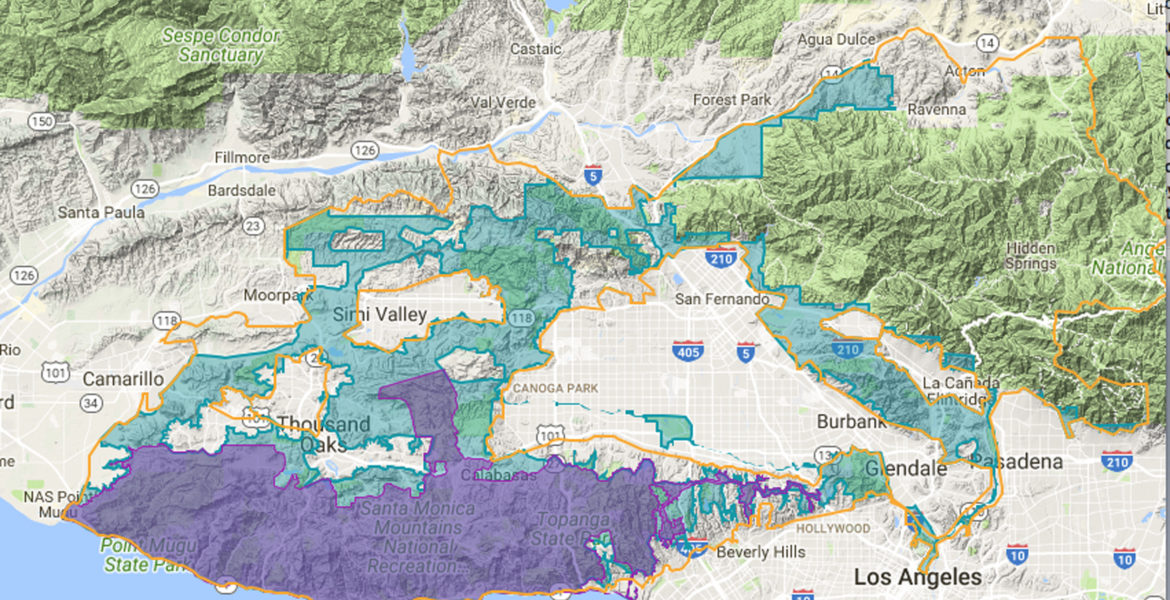THE SANTA MONICA MOUNTAINS NATIONAL RECREATION AREA EXPANSION PLAN IS BACK.
Representative Adam Schiff and California Senator Dianne Feinstein have announced the introduction of the Rim of the Valley Corridor Preservation Act. It’s Schiff’s second attempt to add more than 191,000 acres to the 150,000-acre Santa Monica Mountains National Recreation Area (SMMNRA).
If the new legislation is approved, it would extend the SMMNRA designation to open space in the Simi Hills, Santa Susana, Verdugo, San Gabriel Mountains, and even part of the L.A. River.
The Rim project has been a priority for Schiff for many years. In 2008, he worked to pass the Rim of the Valley Corridor Study Act, which directed the National Park Service (NPS ) to conduct a resource and feasibility study for the park plan and gather stakeholder input. The NPS study was completed in 2016, but the bill to create the park failed to gain traction.
Despite the most anti-park administration in decades, Schiff and Feinstein say they are confident the new proposal can get the support it needs this time.
“Preserving access to open spaces is essential for quality of life in the Los Angeles basin, as more and more land is lost to urban areas,” said Feinstein in a press release. The bill, she continued, “enjoys broad public support because it ensures Southern Californians will have continued access to public lands for recreation and protects critical areas for wildlife habit while respecting private property and local land-use authorities.”
The Rim of the Valley Corridor Preservation Act would expand the SMMNRA to include much, but not all of the land included in the study. The lands within the expansion will be known as the “Rim of the Valley Unit.” The designation will “enable NPS and the local community to better protect natural resources and habitats, and provide members of the community with improved access to nature for recreational and educational purposes.”
A big part of that “not all” is the 2,668-acre Santa Susanna Field Laboratory site. It’s a major exclusion from the original proposed park boundaries. (See related article, “NAME TKTK,” on page TK.)
The field lab, once owned by Rocketdyne, was the scene of a major nuclear reactor accident in 1959. It’s currently owned by Boeing and is undergoing mitigation for the industrial contamination. Much of the radioactive contamination has already been addressed, but toxins dating from the era when NASA tested its space program rockets at the site continue to be an issue. However, the site is also a critical section of habitat for species that include mountain lions, as well as home to historic NASA facilities that were essential to the space race. Park advocates have argued that it should be included in the Rim plan.
If the Rim of the Valley bill passes, the lands that are included in the expansion will be managed the same way the existing SMMNRA is handled, with cooperation between federal, state and local park agencies, as well as private landowners.
The Rim study found that 47 percent of Californians—six percent of the total U.S. population— live within two hours of the study area.
“The legislation would build upon the successful cooperative model that the National Park Service has formed with Los Angeles communities and will bring tremendous benefits to the region’s 17 million residents,” said Dennis Arguelles, Los Angeles Program Manager for National Parks Conservation Association.
The original SMMNRA was created in 1978 by an Act of Congress, and signed into existence by President Jimmy Carter. For many local activists, it’s hard to imagine President Donald Trump, who has declared war on public lands, signing legislation that would more than double the size of the nation’s largest urban park, but Schiff remains optimistic.
“The Rim of the Valley is the critical bridge between the urban city centers, suburbs in the Los Angeles basin and the spectacular wilderness beyond—our bill would help protect these lands for generations to come,” said Schiff. “As more of this area is developed and open space diminishes, the wildlife it supports is increasingly at risk. Congress must preserve the Rim of the Valley for generations to come, but we must act quickly on a bipartisan basis, or this once-in-a- century opportunity will be gone.”


